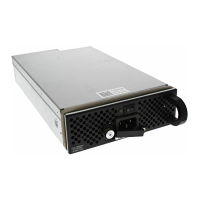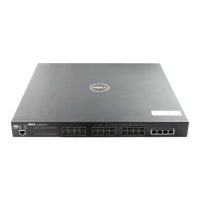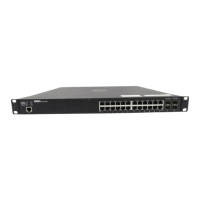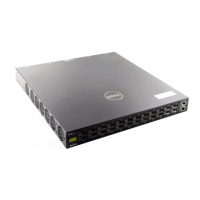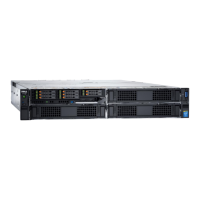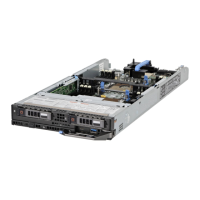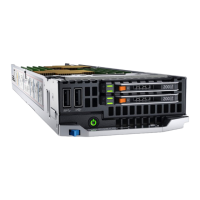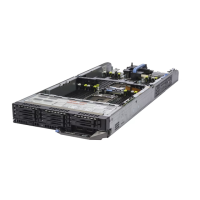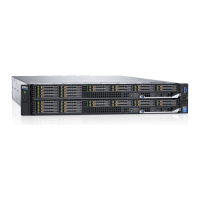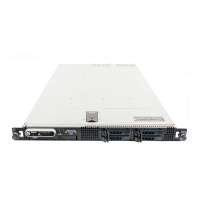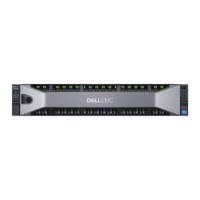Do you have a question about the Dell Force10 MXL Blade and is the answer not in the manual?
Defines the purpose and intended scope of this guide.
Identifies the target audience and their assumed knowledge.
Explains the typographical and symbolic conventions used in the document.
Describes the meaning of various symbols used for notes, cautions, and warnings.
Lists other Dell Force10 documentation for further information.
Details how to access the command-line interface via console or Telnet.
Explains how FTOS handles multiple users in configuration mode.
Describes the CLI prompt structure and how it changes between modes.
Provides methods to access help for commands and keywords within the CLI.
Explains how to use the 'no' keyword to disable or revert commands to default.
Describes how to filter output of 'show' commands using pipe (|) and keywords.
Details the different command modes available in the CLI and how to navigate them.
Describes the default mode upon login, used for viewing settings and accessing privilege mode.
Explains how to enter EXEC Privilege mode and its capabilities.
Details how to enter configuration mode and its purpose.
Describes how to enter interface mode for configuring ports and IP services.
Used to configure console or virtual terminal parameters.
For configuring standard or extended MAC access control lists.
For configuring standard or extended IP access control lists.
Used for configuring route maps and redistribution criteria.
For configuring prefix lists.
For enabling and configuring the Spanning Tree Protocol (STP).
For enabling and configuring the Per-VLAN Spanning Tree (PVST+) protocol.
For enabling and configuring the Rapid Spanning Tree Protocol (RSTP).
For enabling and configuring the Multiple Spanning Tree Protocol (MSTP).
For enabling and configuring GARP VLAN Registration Protocol (GVRP).
For configuring Open Shortest Path First (OSPF).
For configuring Routing Information Protocol (RIP).
Introduces commands for managing configuration files and other file operations.
Lists common commands for file management operations like copy, delete, dir, etc.
Lists commands related to controlling and monitoring the switch system.
Describes the u-Boot mode and its supported commands.
Lists the available commands for the u-Boot environment.
Introduces ACLs, IP prefix lists, and route maps supported by FTOS.
Lists commands applicable to all ACL modes, without mode-specific options.
Details commands for standard and extended IP ACLs.
Covers commands for configuring standard IP Access Control Lists.
Covers commands for configuring extended IP Access Control Lists.
Lists commands for configuring MAC access lists.
Covers commands for configuring standard MAC Access Control Lists.
Covers commands for configuring extended MAC Access Control Lists.
Commands for configuring IP prefix lists.
Commands for configuring route maps and their redistribution criteria.
Explains Bare Metal Provisioning (BMP) for auto-configuration.
Lists commands related to BMP, such as reload-type and show commands.
Introduces the CAM profiling feature for partitioning CAM for application needs.
Lists commands for configuring and managing CAM profiles.
Provides crucial information regarding CAM configuration and its effects.
Explains Data Center Bridging (DCB) and its features like PFC, ETS, and DCBX.
Details the 'dcb-enable' command for enabling Data Center Bridging.
Lists commands for configuring Priority Flow Control (PFC).
Explains DHCP as a protocol for dynamic IP address assignment.
Commands for configuring the switch to act as a DHCP server.
Commands for configuring the switch to act as a DHCP client.
Lists additional commands related to DHCP client functionality.
Commands for implementing secure DHCP features.
Explains FIP snooping for FCoE traffic in converged Ethernet networks.
Lists commands for configuring and verifying FIP snooping.
Lists the commands used for configuring and monitoring GARP VLAN Registration Protocol.
Provides crucial information and limitations regarding GVRP operation.
Lists commands for configuring and managing IGMP snooping.
Provides key considerations and supported features for IGMP snooping.
Highlights important factors for configuring the IGMP snooping querier.
Introduces interface commands and divides the chapter into sections.
Details commands for configuring physical, loopback, and null interfaces.
Commands for configuring Link Aggregation Groups (LAGs) or Port Channels.
Explains TDR for troubleshooting copper cable issues on interfaces.
Describes the UDP broadcast feature for forwarding low-throughput traffic.
Lists the commands related to IPv4 routing configuration and monitoring.
Explains iSCSI optimization for quality-of-service (QoS) treatment of storage traffic.
Lists commands for configuring and verifying iSCSI Optimization features.
Introduces LACP for creating dynamic link aggregation groups (LAGs).
Lists the commands used for configuring and monitoring LACP.
Describes commands for configuring Layer 2 features.
Commands for configuring, managing, and viewing MAC addresses.
Commands for configuring and monitoring virtual local area networks (VLANs).
Explains LLDP for advertising connectivity and management information.
Lists commands for configuring and monitoring LLDP.
Details LLDP-MED commands, extending LLDP with organizationally specific TLVs.
Describes MSTP implementation based on IEEE 802.1s.
Lists commands for configuring and monitoring the Multiple Spanning Tree Protocol.
Explains OSPFv2 as an interior gateway protocol for routing information distribution.
Lists commands for configuring and enabling OSPFv2.
Explains the port monitoring feature for traffic analysis.
Lists commands for configuring and monitoring port monitoring sessions.
Provides key considerations for using the port monitoring feature.
Lists commands for configuring and monitoring private VLANs.
Explains primary, secondary, community, isolated VLANs, and port types.
Describes PVST+ based on IEEE 802.1d, creating a separate spanning tree per VLAN.
Lists commands for configuring and monitoring PVST+.
Introduces QoS commands for traffic conditioning and congestion control.
Lists commands for global QoS configuration.
Details commands for defining QoS configuration on a per-physical-port basis.
Commands for handling policy-based traffic classification using class maps.
Describes commands for AAA, RADIUS, TACACS+, SSH, and DHCP security.
Commands for tracking user activity and network resource consumption.
Commands for setting command-line authorization and privilege levels.
Commands controlling management access to the system via authentication.
Commands for configuring RADIUS server communication.
Commands for configuring TACACS+ for login authentication.
Commands for configuring secure shell (SSH) and secure copy protocol (SCP).
Features that protect networks using dynamic address allocation from spoofing.
Explains the sFlow monitoring system with agents and collectors.
Provides key considerations and limitations of the sFlow feature.
Lists commands for configuring and verifying the sFlow monitoring system.
Describes commands for configuring and monitoring SNMP and Syslog.
Lists commands for configuring and monitoring SNMP operations.
Commands for configuring logging functions for Dell Force10 switches.
Explains the storm control feature to limit or suppress traffic during a storm.
Lists commands for configuring and monitoring storm control features.
Provides key considerations for configuring storm control.
Describes commands for managing stacking of MXL 10/40GbE switch systems.
Lists commands for managing switch stacking configurations.
Describes STP based on IEEE 802.1d for network connectivity.
Lists commands for configuring and monitoring the Spanning Tree Protocol.
Explains commands for configuring system time using FTOS, hardware, or NTP.
Lists commands for NTP configuration and management.
Explains UFD for detecting loss of upstream connectivity and automatic recovery.
Lists commands for configuring and managing Uplink Failure Detection.
Describes VLAN stacking (stacked VLANs and QinQ) for transparently switching VLANs.
Provides key considerations for using VLAN stacking.
Lists commands for configuring and monitoring VLAN stacking features.
Lists commands for configuring and managing Virtual Router Redundancy Protocol.
Provides commands for isolating faults and debugging hardware offline.
Commands for adjusting buffer allocations for queues.
Commands to display information from hardware sub-components or ASICs.
Lists and describes ICMP message types resulting from a ping.
Lists traps sent by FTOS, including Message ID, Trap Type, and Trap Option.
Defines the purpose and intended scope of this guide.
Identifies the target audience and their assumed knowledge.
Explains the typographical and symbolic conventions used in the document.
Describes the meaning of various symbols used for notes, cautions, and warnings.
Lists other Dell Force10 documentation for further information.
Details how to access the command-line interface via console or Telnet.
Explains how FTOS handles multiple users in configuration mode.
Describes the CLI prompt structure and how it changes between modes.
Provides methods to access help for commands and keywords within the CLI.
Explains how to use the 'no' keyword to disable or revert commands to default.
Describes how to filter output of 'show' commands using pipe (|) and keywords.
Details the different command modes available in the CLI and how to navigate them.
Describes the default mode upon login, used for viewing settings and accessing privilege mode.
Explains how to enter EXEC Privilege mode and its capabilities.
Details how to enter configuration mode and its purpose.
Describes how to enter interface mode for configuring ports and IP services.
Used to configure console or virtual terminal parameters.
For configuring standard or extended MAC access control lists.
For configuring standard or extended IP access control lists.
Used for configuring route maps and redistribution criteria.
For configuring prefix lists.
For enabling and configuring the Spanning Tree Protocol (STP).
For enabling and configuring the Per-VLAN Spanning Tree (PVST+) protocol.
For enabling and configuring the Rapid Spanning Tree Protocol (RSTP).
For enabling and configuring the Multiple Spanning Tree Protocol (MSTP).
For enabling and configuring GARP VLAN Registration Protocol (GVRP).
For configuring Open Shortest Path First (OSPF).
For configuring Routing Information Protocol (RIP).
Introduces commands for managing configuration files and other file operations.
Lists common commands for file management operations like copy, delete, dir, etc.
Lists commands related to controlling and monitoring the switch system.
Describes the u-Boot mode and its supported commands.
Lists the available commands for the u-Boot environment.
Introduces ACLs, IP prefix lists, and route maps supported by FTOS.
Lists commands applicable to all ACL modes, without mode-specific options.
Details commands for standard and extended IP ACLs.
Covers commands for configuring standard IP Access Control Lists.
Covers commands for configuring extended IP Access Control Lists.
Lists commands for configuring MAC access lists.
Covers commands for configuring standard MAC Access Control Lists.
Covers commands for configuring extended MAC Access Control Lists.
Commands for configuring IP prefix lists.
Commands for configuring route maps and their redistribution criteria.
Explains Bare Metal Provisioning (BMP) for auto-configuration.
Lists commands related to BMP, such as reload-type and show commands.
Introduces the CAM profiling feature for partitioning CAM for application needs.
Lists commands for configuring and managing CAM profiles.
Provides crucial information regarding CAM configuration and its effects.
Explains Data Center Bridging (DCB) and its features like PFC, ETS, and DCBX.
Details the 'dcb-enable' command for enabling Data Center Bridging.
Lists commands for configuring Priority Flow Control (PFC).
Explains DHCP as a protocol for dynamic IP address assignment.
Commands for configuring the switch to act as a DHCP server.
Commands for configuring the switch to act as a DHCP client.
Lists additional commands related to DHCP client functionality.
Commands for implementing secure DHCP features.
Explains FIP snooping for FCoE traffic in converged Ethernet networks.
Lists commands for configuring and verifying FIP snooping.
Lists the commands used for configuring and monitoring GARP VLAN Registration Protocol.
Provides crucial information and limitations regarding GVRP operation.
Lists commands for configuring and managing IGMP snooping.
Provides key considerations and supported features for IGMP snooping.
Highlights important factors for configuring the IGMP snooping querier.
Introduces interface commands and divides the chapter into sections.
Details commands for configuring physical, loopback, and null interfaces.
Commands for configuring Link Aggregation Groups (LAGs) or Port Channels.
Explains TDR for troubleshooting copper cable issues on interfaces.
Describes the UDP broadcast feature for forwarding low-throughput traffic.
Lists the commands related to IPv4 routing configuration and monitoring.
Explains iSCSI optimization for quality-of-service (QoS) treatment of storage traffic.
Lists commands for configuring and verifying iSCSI Optimization features.
Introduces LACP for creating dynamic link aggregation groups (LAGs).
Lists the commands used for configuring and monitoring LACP.
Describes commands for configuring Layer 2 features.
Commands for configuring, managing, and viewing MAC addresses.
Commands for configuring and monitoring virtual local area networks (VLANs).
Explains LLDP for advertising connectivity and management information.
Lists commands for configuring and monitoring LLDP.
Details LLDP-MED commands, extending LLDP with organizationally specific TLVs.
Describes MSTP implementation based on IEEE 802.1s.
Lists commands for configuring and monitoring the Multiple Spanning Tree Protocol.
Explains OSPFv2 as an interior gateway protocol for routing information distribution.
Lists commands for configuring and enabling OSPFv2.
Explains the port monitoring feature for traffic analysis.
Lists commands for configuring and monitoring port monitoring sessions.
Provides key considerations for using the port monitoring feature.
Lists commands for configuring and monitoring private VLANs.
Explains primary, secondary, community, isolated VLANs, and port types.
Describes PVST+ based on IEEE 802.1d, creating a separate spanning tree per VLAN.
Lists commands for configuring and monitoring PVST+.
Introduces QoS commands for traffic conditioning and congestion control.
Lists commands for global QoS configuration.
Details commands for defining QoS configuration on a per-physical-port basis.
Commands for handling policy-based traffic classification using class maps.
Describes commands for AAA, RADIUS, TACACS+, SSH, and DHCP security.
Commands for tracking user activity and network resource consumption.
Commands for setting command-line authorization and privilege levels.
Commands controlling management access to the system via authentication.
Commands for configuring RADIUS server communication.
Commands for configuring TACACS+ for login authentication.
Commands for configuring secure shell (SSH) and secure copy protocol (SCP).
Features that protect networks using dynamic address allocation from spoofing.
Explains the sFlow monitoring system with agents and collectors.
Provides key considerations and limitations of the sFlow feature.
Lists commands for configuring and verifying the sFlow monitoring system.
Describes commands for configuring and monitoring SNMP and Syslog.
Lists commands for configuring and monitoring SNMP operations.
Commands for configuring logging functions for Dell Force10 switches.
Explains the storm control feature to limit or suppress traffic during a storm.
Lists commands for configuring and monitoring storm control features.
Provides key considerations for configuring storm control.
Describes commands for managing stacking of MXL 10/40GbE switch systems.
Lists commands for managing switch stacking configurations.
Describes STP based on IEEE 802.1d for network connectivity.
Lists commands for configuring and monitoring the Spanning Tree Protocol.
Explains commands for configuring system time using FTOS, hardware, or NTP.
Lists commands for NTP configuration and management.
Explains UFD for detecting loss of upstream connectivity and automatic recovery.
Lists commands for configuring and managing Uplink Failure Detection.
Describes VLAN stacking (stacked VLANs and QinQ) for transparently switching VLANs.
Provides key considerations for using VLAN stacking.
Lists commands for configuring and monitoring VLAN stacking features.
Lists commands for configuring and managing Virtual Router Redundancy Protocol.
Provides commands for isolating faults and debugging hardware offline.
Commands for adjusting buffer allocations for queues.
Commands to display information from hardware sub-components or ASICs.
Lists and describes ICMP message types resulting from a ping.
Lists traps sent by FTOS, including Message ID, Trap Type, and Trap Option.
| Switching Capacity | 1.28 Tbps |
|---|---|
| Forwarding Rate | 952 Mpps |
| Product Type | Blade Switch |
| Latency | < 3 microseconds |
| Operating Temperature | 0°C to 40°C (32°F to 104°F) |
| Redundancy | Yes |
| Management | CLI, SNMP, Web |
| Layer Support | Layer 2, Layer 3 |
| Jumbo Frame Support | Up to 9216 bytes |
| Management Ports | 1 x 10/100/1000 Mbps |
| Storage Temperature | -40°C to 70°C |
| Weight | 4.5 kg (9.9 lbs) |
